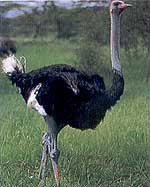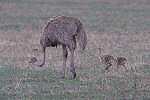OSTRICH


How to Recognize
Ostriches are the world’s tallest living bird (up to 9 feet) with the largest eyes of any land animal (2 inches in diameter – check out the lashes!). They therefore have keen eyesight. These huge flightless birds have long, featherless necks and muscular legs. Males are black and white in color, while females are gray-brown.
Habitat
They can be found in dry, open savanna, desert, and semi-desert areas.
Behavior
Ostriches can be found alone or in groups, but they generally seek safety in flocks. They can be found among herds of antelopes or zebras which lessens the chance of being surprised by a predator. They can live for thirty to forty years. When two families meet, a dispute usually starts and the winning pair adopts the other’s chicks – groups of up to 100 to 300 young can form.
Breeding
During courtship displays, males crouch while rotating outstretched wings and sway their neck from side to side. This attracts the females, and normally two to five ostriches (but up to 18) lay eggs in the same nest. Only the male and the first hen who had laid eggs can incubate, he by night and she by day.
Up to 78 eggs have been recorded in one nest but only 20 can be incubated at one time. The hen rolls away those that aren't hers (perhaps she recognizes her own by the size, structure, and shape of pores in the shell). The other eggs are scavenged by hyenas and jackals.
If threatened while sitting on the nest, the hen presses her long neck flat along the ground trying to blend with the background.
(Contrary to popular belief, ostriches don't bury their heads in the sand.) Chicks leave the nest within three days and follow their parents for the next twelve months.
Feeding
Ostriches feed on seeds, fruits, leaves, insects, lizards, and small tortoises. Sand, stones, and even coins and nails are swallowed to help digestion. They aren't dependent on water.
Enemies
When running from a predator, they can run sprints at 44 mph in 4-foot strides. They can outpace any predator at 31 mph for up to 30 minutes. In a tight spot, an ostrich can kill a lion by kicking with its massive feet – the inner claw has a 4-inch spike.
TOP OF PAGE
Copyright © 2002, Dawn M. Dalton.
All rights reserved.
**LINKS**
WHERE?
WHY?
ITINERARY
PLAN YOUR TRIP
GETTING THERE
LONDON
KENYA
UGANDA
SAFETY
ITEMS BOUGHT
STAYING HEALTHY
COMMENTS
HOME
BHS HOME
---Animal Facts--
Baboon
Buffalo
Cheetah
Chimpanzee
Crocodile
Eland
Elephant
Gazelle
Giant Forest Hog
Giraffe
Gorilla
Hippopotamus
Hyena
Hyrax
Impala
Jackal
Lion
Mongoose
Monkey
Ostrich
Rhinoceros
Topi
Uganda Kob
Warthog
Waterbuck
Wildebeest
Zebra